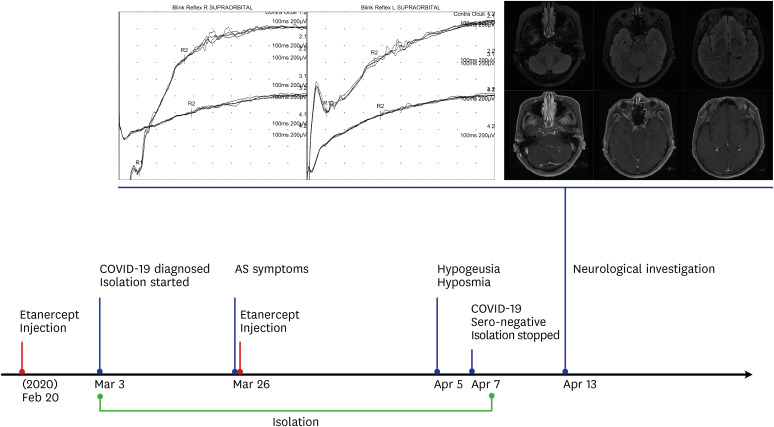J Korean Med Sci.
2020 Jun;35(21):e201. 10.3346/jkms.2020.35.e201.
Olfactory and Gustatory Dysfunction in a COVID-19 Patient with Ankylosing Spondylitis Treated with Etanercept: Case Report
- Affiliations
-
- 1Department of Neurology, School of Medicine, Kyungpook National University, Daegu, Korea
- 2Division of Rheumatology, Department of Internal Medicine, School of Medicine, Kyungpook National University, Daegu, Korea
- KMID: 2502246
- DOI: http://doi.org/10.3346/jkms.2020.35.e201
Abstract
- The neurologic manifestations concerning coronavirus disease 2019 (COVID-19) are highly penetrated. Anosmia and ageusia are one of the common acute neurologic symptoms, which develop in the early stage of COVID-19. However, it is not reported that how immunosuppressive agents affect these symptoms. We report olfactory and gustatory dysfunctions in a patient with ankylosing spondylitis (AS) treated with etanercept during COVID-19. A 53-year-old female showing AS controlled with tumor necrosis factor-α inhibitor, etanercept, had been diagnosed with severe acute respiratory syndrome coronavirus 2 (SARS-CoV-2) infection, presenting cough and rhinorrhea. One month after diagnosis, she complained about hyposmia and hypogeusia two days before the seronegative conversion of SARS-CoV-2, which were confirmed by a neurological examination. We speculate that the etanercept may have delayed the development of olfactory and gustatory dysfunction in the patient.
Keyword
Figure
Cited by 2 articles
-
Trend of Olfactory and Gustatory Dysfunction in COVID-19 Patients in a Quarantine Facility
Min Young Seo, Hyeri Seok, Sun Jin Hwang, Hee Kyoung Choi, Ji Hoon Jeon, Jang Wook Sohn, Dae Won Park, Seung Hoon Lee, Won Suk Choi
J Korean Med Sci. 2020;35(41):e375. doi: 10.3346/jkms.2020.35.e375.Coping with Dementia in the Middle of the COVID-19 Pandemic
Nayoung Ryoo, Jung-Min Pyun, Min Jae Baek, Jeewon Suh, Min Ju Kang, Min Jeong Wang, Young Chul Youn, Dong Won Yang, Seong Yoon Kim, Young Ho Park, SangYun Kim
J Korean Med Sci. 2020;35(42):e383. doi: 10.3346/jkms.2020.35.e383.
Reference
-
1. Lechien JR, Chiesa-Estomba CM, De Siati DR, Horoi M, Le Bon SD, Rodriguez A, et al. Olfactory and gustatory dysfunctions as a clinical presentation of mild-to-moderate forms of the coronavirus disease (COVID-19): a multicenter European study. Eur Arch Otorhinolaryngol. 2020.
Article2. Mao L, Jin H, Wang M, Hu Y, Chen S, He Q, et al. Neurologic manifestations of hospitalized patients with coronavirus disease 2019 in Wuhan, China. JAMA Neurol. 2020.
Article3. Vaira LA, Salzano G, Deiana G, De Riu G. Anosmia and ageusia: common findings in COVID-19 patients. Laryngoscope. 2020.4. Gilani S, Roditi R, Naraghi M. COVID-19 and anosmia in Tehran, Iran. Med Hypotheses. 2020; 141:109757. PMID: 32344276.
Article5. Misra DP, Agarwal V, Gasparyan AY, Zimba O. Rheumatologists' perspective on coronavirus disease 19 (COVID-19) and potential therapeutic targets. Clin Rheumatol. 2020.
Article6. Winthrop KL, Mariette X, Silva JT, Benamu E, Calabrese LH, Dumusc A, et al. ESCMID Study Group for Infections in Compromised Hosts (ESGICH) Consensus Document on the safety of targeted and biological therapies: an infectious diseases perspective (soluble immune effector molecules [II]: agents targeting interleukins, immunoglobulins and complement factors). Clin Microbiol Infect. 2018; 24(Suppl 2):S21–40. PMID: 29447987.
Article7. Duret PM, Sebbag E, Mallick A, Gravier S, Spielmann L, Messer L. Recovery from COVID-19 in a patient with spondyloarthritis treated with TNF-alpha inhibitor etanercept. Ann Rheum Dis. 2020.
Article8. Monti S, Balduzzi S, Delvino P, Bellis E, Quadrelli VS, Montecucco C. Clinical course of COVID-19 in a series of patients with chronic arthritis treated with immunosuppressive targeted therapies. Ann Rheum Dis. 2020; 79(5):667–668. PMID: 32241793.
Article9. Lee Y, Min P, Lee S, Kim SW. Prevalence and duration of acute loss of smell or taste in COVID-19 patients. J Korean Med Sci. 2020; 35(18):e174. PMID: 32383370.
Article10. Xu H, Zhong L, Deng J, Peng J, Dan H, Zeng X, et al. High expression of ACE2 receptor of 2019-nCoV on the epithelial cells of oral mucosa. Int J Oral Sci. 2020; 12(1):8. PMID: 32094336.
Article11. Yan R, Zhang Y, Li Y, Xia L, Guo Y, Zhou Q. Structural basis for the recognition of SARS-CoV-2 by full-length human ACE2. Science. 2020; 367(6485):1444–1448. PMID: 32132184.
Article
- Full Text Links
- Actions
-
Cited
- CITED
-
- Close
- Share
- Similar articles
-
- Characteristics and Prognosis of COVID-19 Induced Olfactory and Gustatory Dysfunction in Daegu
- Comparative Analysis of Olfactory and Gustatory Function of Patients With COVID-19 Olfactory Dysfunction and Non-COVID-19 Postinfectious Olfactory Dysfunction
- A Case of Ankylosing Spondylitis Accompanying Sarcoidosis
- TNF Inhibitors and Uveitis in Ankylosing Spondylitis
- Regional and Chronological Variation of Chemosensory Dysfunction in COVID-19: a Meta-Analysis


